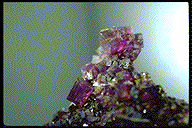

- Chemistry: Pb5Cu4Cl10(OH)8 - 2H2O, Hydrated Lead Copper Chloride Hydroxide
- Class: Halides
- Uses: A very minor ore of copper and lead and as mineral specimens.
Specimens
Pseudoboleite is a mineral that is often intergrown with its "false" self. It is closely related to boleite, whose cumbersome formula is Pb26Cu24Ag10Cl62(OH) 48 - 3H2O. Pseudoboleite gets its name by being a false boleite (pseudo means false). Boleite was named for Boleo, Santa Rosalia, Baja California, Mexico which is the type locality for both minerals. The French colonial town of Santa Rosalia was built near the copper mines that extracted copper from the unusual sedimentary copper deposits. Pseudoboleite and boleite specimens can still be found in these deposits although they are scarce and not easy to find. Pseudoboleite forms tiny blocky crystals on top of the boleite's crystal faces that are called epitaxial overgrowths. Pseudoboleite is often intergrown with boleite inside these crystals in an example of parallel growth. The two minerals are also known to be intergrown with the mineral cumengite, (Pb21Cu20Cl42 (OH)40).
All three minerals are very rare and have very unusual chemistries.
These halides and others with similar chemistries belong to a division in the
Halides Class called the Oxyhalides and Hydroxyhalides.
These minerals have either oxygen or hydroxide groups in their chemistries.
The oxygen atom in their chemistries might require their classification in the
Oxides Class of minerals except that their structures are more tied to the halide elements and the oxygens and hydroxides are kind of superfluous to the overall structure.
Some other members of the Oxyhalides and Hydroxyhalides include
bideauxite,
PHYSICAL CHARACTERISTICS:
- Color is indigo blue.
- Luster is vitreous to pearly.
- Transparency: Crystals are usually translucent to transparent.
- Crystal System is tetragonal; 4 2 2
- Crystal Habits include tiny blocky crystals on top of the boleite's crystal faces; a form of epitaxial overgrowth. It is often intergrown with boleite in parallel growth. Crystals can be pseudocubic.
- Cleavage is perfect.
- Fracture is uneven.
- Hardness is 2.5
- Specific Gravity is 4.9 - 5.0 (rather heavy for translucent minerals)
- Streak is light green to blue.
- Associated Minerals include other rare copper and lead chlorides such as
boleite,
cumengite,
chloroxiphite , paralaurionite,matlockite , chlorargyrite, atacamite,mendipite and diaboleite. Also found with cerussite, smithsonite, connellite,gerhardtite , cuprite, leadhillite, clays, linarite, phosgenite and chrysocolla. - Notable Occurrences include Boleo, Santa Rosalia, Baja California, Mexico and the Mammoth District, Arizona, USA and most places where boleite is found.
- Best Field Indicators are crystals habit, color, density, streak and locality.





